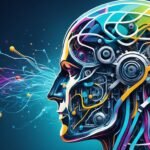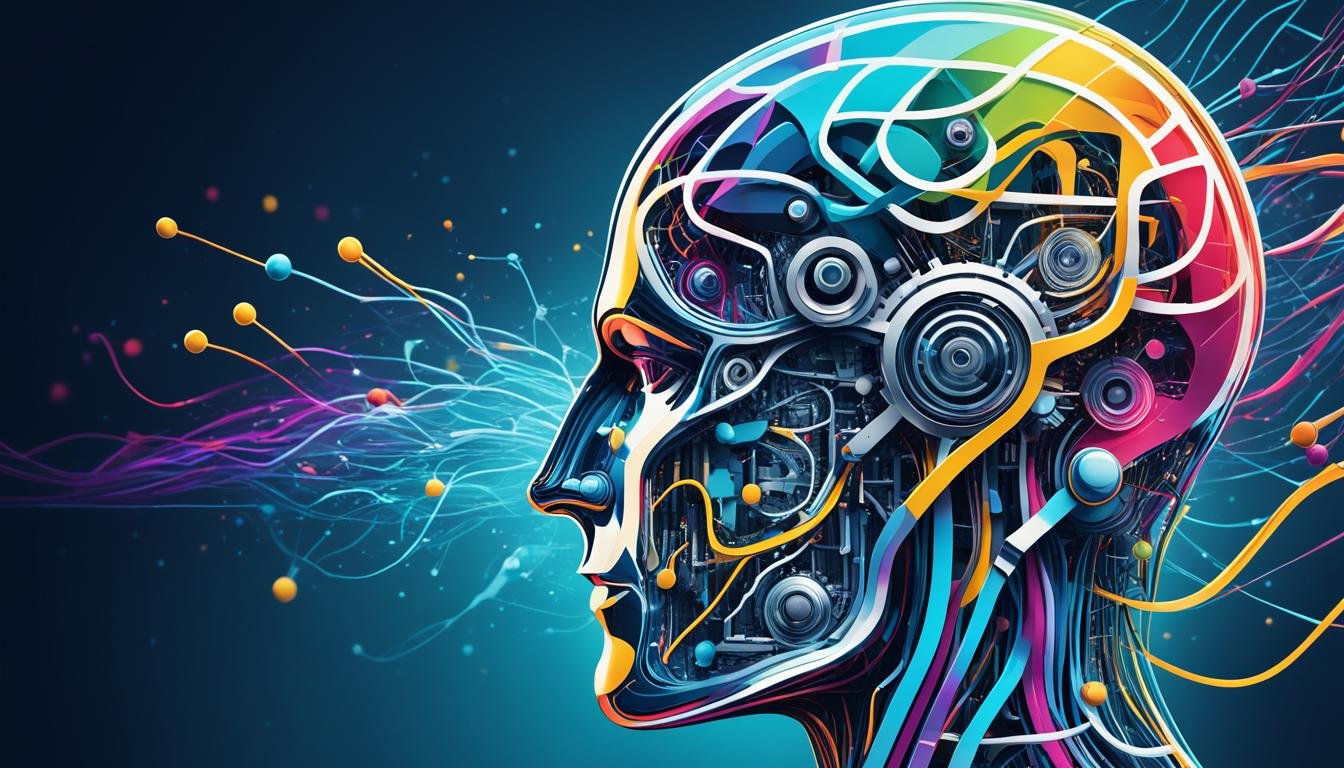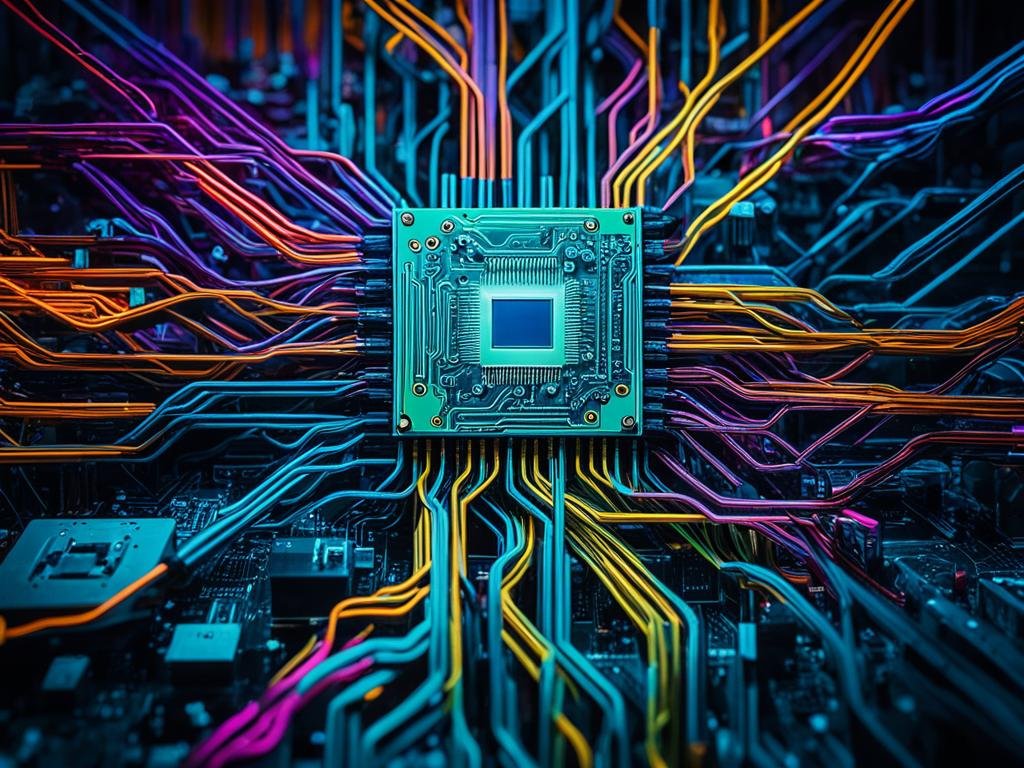Artificial Intelligence (AI) and Machine Learning (ML) have become powerful technologies that are changing the landscape of multiple industries. From healthcare to finance, AI and ML are driving innovation and transforming the way businesses operate.
In this article, I will explore the fundamentals of AI and ML, as well as their applications in healthcare, finance, manufacturing, retail, transportation, education, agriculture, cybersecurity, e-commerce, and business processes. We will also discuss the key takeaways for businesses and the future of AI.
Key Takeaways:
- AI and ML are transforming industries and offering businesses new opportunities for growth and innovation.
- Understanding the fundamentals of AI and ML is crucial for businesses to harness their potential.
- AI technology enables intelligent automation, optimizing routine processes and improving operational efficiency.
- Exploring the diverse applications of AI in various sectors can help businesses identify opportunities for implementation.
- Staying updated with AI advancements is essential for businesses to remain competitive in a rapidly evolving digital landscape.
Understanding AI and Machine Learning Fundamentals
AI and ML are built on the foundation of neural networks and data science. Neural networks, which mimic the structure and function of the human brain, allow machines to learn and make intelligent decisions. Data science involves the collection, analysis, and interpretation of large amounts of data to extract valuable insights.
Machine learning algorithms play a crucial role in driving AI progress by enabling computers to learn from data and make predictions or decisions. These algorithms analyze patterns in data and identify relationships, which are then used to make accurate predictions or take appropriate actions.
Deep learning, a subset of machine learning, is particularly effective at performing complex tasks and handling unstructured data. It leverages neural networks and is more adept at nonlinear reasoning than traditional machine learning methods, making it ideal for applications such as image and speech recognition.
The Building Blocks of AI: Neural Networks and Data Science
Neural networks form the building blocks of AI systems. They consist of artificial neurons or nodes connected in layers, allowing them to process and analyze data. Each node in a neural network receives input data, applies an activation function, and produces an output, which is then passed on to the next layer. This process continues until the final layer produces the desired output.
Data science is a multidisciplinary field that combines statistics, mathematics, and computer science to extract insights from data. Data scientists use various techniques, such as data mining, statistical modeling, and predictive analytics, to uncover patterns and trends in data. This helps businesses and organizations make informed decisions and develop intelligent systems.
Machine Learning Algorithms: The Engine Behind AI Progress
Machine learning algorithms are the engine behind AI progress. These algorithms enable computers to learn from data and make accurate predictions or decisions without being explicitly programmed. There are several types of machine learning algorithms, including:
- Supervised learning: The algorithm learns from labeled data, where the desired output is known. It maps input data to the correct output based on training examples.
- Unsupervised learning: The algorithm learns from unlabeled data, where the desired output is unknown. It identifies patterns and relationships in the data without any predefined labels.
- Reinforcement learning: The algorithm learns through trial and error by interacting with an environment and receiving feedback in the form of rewards or penalties.
Each type of machine learning algorithm has its own strengths and applications, and businesses can choose the most suitable algorithm based on their specific needs and data.
Deep Learning vs. Traditional Machine Learning: What’s the Difference?
Deep learning, as a subset of machine learning, differs from traditional machine learning methods in its ability to automatically learn hierarchical representations from data. While traditional machine learning models rely on handcrafted feature engineering, deep learning algorithms automatically learn relevant features from raw data, eliminating the need for manual feature extraction.
Deep learning models, such as deep neural networks, are composed of multiple layers of artificial neurons. Each layer learns increasingly complex features, allowing the model to solve complex problems. This makes deep learning well-suited for tasks such as image and speech recognition, natural language processing, and recommendation systems.
In contrast, traditional machine learning methods require explicit feature engineering, where domain experts manually select and design features that are relevant to the problem at hand. While traditional machine learning methods are still widely used and effective for many applications, deep learning has shown superior performance in certain domains.
Revolutionizing Healthcare with Intelligent Automation
As technology continues to advance, healthcare is one industry that has greatly benefited from the integration of artificial intelligence (AI) and machine learning. With the help of intelligent automation, healthcare providers can enhance diagnostic accuracy, improve drug discovery, and deliver personalized care to patients. In this section, we will explore how AI and machine learning are revolutionizing healthcare.
Enhancing Diagnostic Accuracy Through Machine Learning
One of the key applications of machine learning in healthcare is enhancing diagnostic accuracy. By analyzing large volumes of medical images and patient data, machine learning algorithms can detect patterns and anomalies that may be missed by human physicians. This enables early detection of diseases, such as cancer, and improves treatment planning for patients.
The use of machine learning algorithms has shown promising results in various medical imaging modalities, including radiology, pathology, and dermatology. These algorithms can help identify subtle signs of diseases, assist in differentiating between benign and malignant conditions, and provide valuable insights for accurate diagnoses.
AI-Powered Drug Discovery & Virtual Health Assistants
Another significant application of AI in healthcare is AI-powered drug discovery. Traditionally, the process of discovering new drugs can be lengthy and costly. However, with the aid of machine learning algorithms, researchers can analyze vast amounts of data to predict the efficacy of drug compounds and identify potential treatments more efficiently.
In addition to drug discovery, virtual health assistants powered by AI are transforming patient care. Virtual health assistants can provide personalized health advice, monitor patients’ vital signs remotely, and assist in managing chronic conditions. These AI-powered assistants improve patient engagement and enable healthcare providers to deliver more personalized care while alleviating the burden on medical staff.

With the integration of intelligent automation, machine learning, and AI-powered technologies, healthcare is experiencing a significant transformation. Improved diagnostic accuracy, efficient drug discovery, and personalized patient care are just a few examples of the advancements that are revolutionizing healthcare. As AI continues to evolve, the future holds even more possibilities for improving healthcare outcomes and enhancing the overall patient experience.
Artificial Intelligence and Machine Learning in Finance
Automating Financial Analysis and Fraud Detection
The financial industry is harnessing the power of artificial intelligence (AI) and machine learning (ML) to revolutionize financial analysis and fraud detection. Machine learning algorithms analyze vast amounts of financial data to provide accurate predictions and real-time risk assessments, enabling financial institutions to make informed decisions with greater efficiency. By automating financial analysis tasks, such as predicting market trends and detecting fraudulent activities, AI technology enhances the speed and accuracy of these processes.
Financial institutions can utilize AI-powered algorithms to analyze customer data for potential fraudulent activities and patterns, detecting and preventing fraudulent transactions in real-time. This proactive approach to fraud detection helps safeguard the financial security of individuals and businesses alike, reducing potential financial losses.
Additionally, AI-powered chatbots and virtual assistants offer personalized financial advice and recommendations to investors, empowering them to make informed investment decisions. These virtual assistants leverage machine learning to understand customer preferences, risk tolerance, and financial goals, enabling personalized investing strategies.
The integration of AI and ML algorithms brings greater efficiency, security, and personalization to the financial industry. By automating financial analysis and enhancing fraud detection capabilities, financial institutions can streamline their operations, improve decision-making, and provide tailored services to their clients.
Manufacturing Reimagined: The Role of AI in Industry 4.0
AI is revolutionizing the manufacturing industry, ushering in a new era of efficiency and innovation. With the advent of Industry 4.0, AI technologies are transforming traditional manufacturing processes and enabling a range of advanced capabilities.
One of the key applications of AI in manufacturing is predictive maintenance. By leveraging machine learning algorithms, manufacturers can analyze sensor data and predict maintenance needs in real-time. This proactive approach minimizes unplanned downtime, maximizes equipment uptime, and ultimately improves productivity.
Quality control is another area where AI is making significant contributions. Computer vision systems powered by AI can inspect products for defects with unmatched precision and accuracy. This ensures that only high-quality products reach the market, enhancing customer satisfaction and brand reputation.
Inventory management is a critical aspect of manufacturing operations, and AI-powered demand forecasting is streamlining this process. By analyzing historical data, market trends, and other relevant factors, machine learning algorithms can predict demand with greater accuracy. This optimization of inventory management improves cost-efficiency, reduces waste, and enables manufacturers to meet customer demand more effectively.
As AI continues to advance, the manufacturing industry is embracing the opportunities presented by Industry 4.0. By harnessing the power of AI, manufacturers can unlock new levels of productivity, optimization, and innovation. With predictive maintenance, quality control, and demand forecasting, manufacturing is being reimagined, paving the way for a smarter and more efficient future.
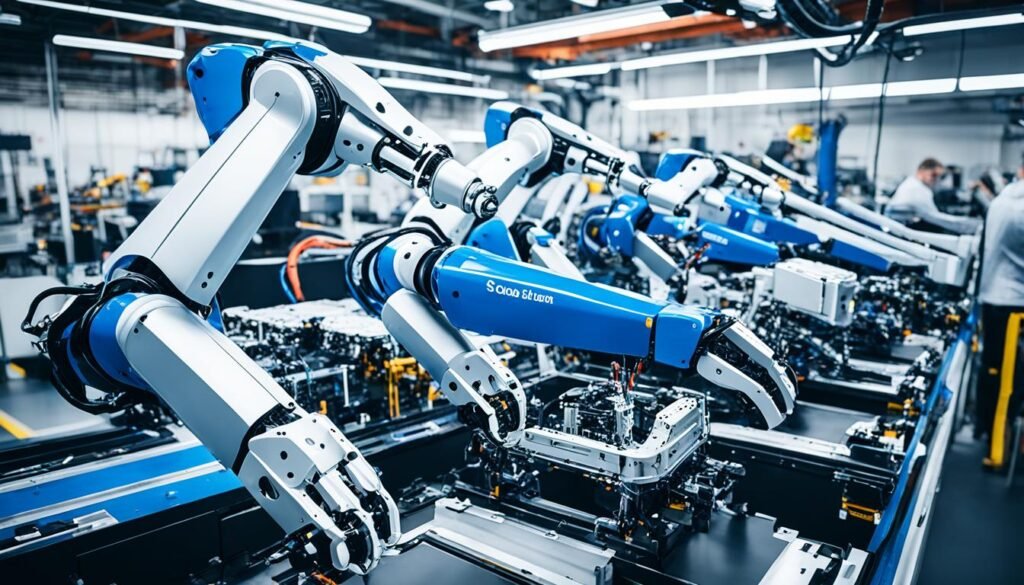
| Benefits of AI in Manufacturing | Applications of AI in Manufacturing |
|---|---|
| Improved efficiency: AI enables predictive maintenance, minimizing downtime and optimizing equipment performance. | Predictive maintenance: Machine learning algorithms analyze sensor data to predict maintenance needs. |
| Enhanced quality control: Computer vision systems detect defects with unmatched precision. | Quality control: AI-powered computer vision systems inspect products for defects. |
| Optimized inventory management: AI-driven demand forecasting improves cost-efficiency and reduces waste. | Demand forecasting: Machine learning algorithms predict demand based on historical data and market trends. |
How AI is Personalizing the Retail Experience
AI is revolutionizing the retail industry by delivering personalized shopping experiences and optimizing operations. With the power of AI and machine learning algorithms, retailers can create customized product recommendations tailored to individual customer preferences, resulting in improved customer engagement and increased sales.
One of the main ways AI enhances the retail experience is through personalized product recommendations. By analyzing vast amounts of customer data, AI algorithms can understand individual shopping habits, preferences, and purchasing history. This enables retailers to suggest products that align with the customer’s interests, increasing the chances of making a sale. These intelligent recommendations not only improve customer satisfaction but also drive higher conversion rates.
Another significant application of AI in the retail industry is inventory management optimization. By leveraging AI technologies, retailers can accurately forecast demand, optimize inventory levels, and reduce waste. AI algorithms analyze various data points such as historical sales data, customer preferences, and market trends to determine the optimal inventory levels for each product. This optimization helps retailers minimize stockouts, reduce excess inventory, and improve overall operational efficiency.
In addition to personalized recommendations and inventory management, AI-powered chatbots are transforming customer service in retail. These virtual assistants use natural language processing and machine learning algorithms to assist customers in finding products, answering queries, and providing exceptional customer support. AI chatbots can handle a wide range of customer interactions, ensuring prompt and efficient service around the clock.
Overall, the integration of AI in retail is transforming the industry, providing customers with personalized experiences and helping retailers optimize their operations. With customized product recommendations, inventory management optimization, and AI-powered chatbots, retailers can streamline their processes, improve customer satisfaction, and drive business growth.
Transportation and Logistics: Navigating the Future with AI
AI and ML are reshaping the transportation and logistics industry by advancing autonomous vehicles and optimizing logistics operations. Machine learning algorithms enable vehicles to analyze real-time data, enhancing safety and navigation. AI-driven logistics optimization algorithms streamline routes, minimize fuel consumption, and improve delivery schedules. These advancements are paving the way for a future with safer and more efficient transportation and logistics systems.
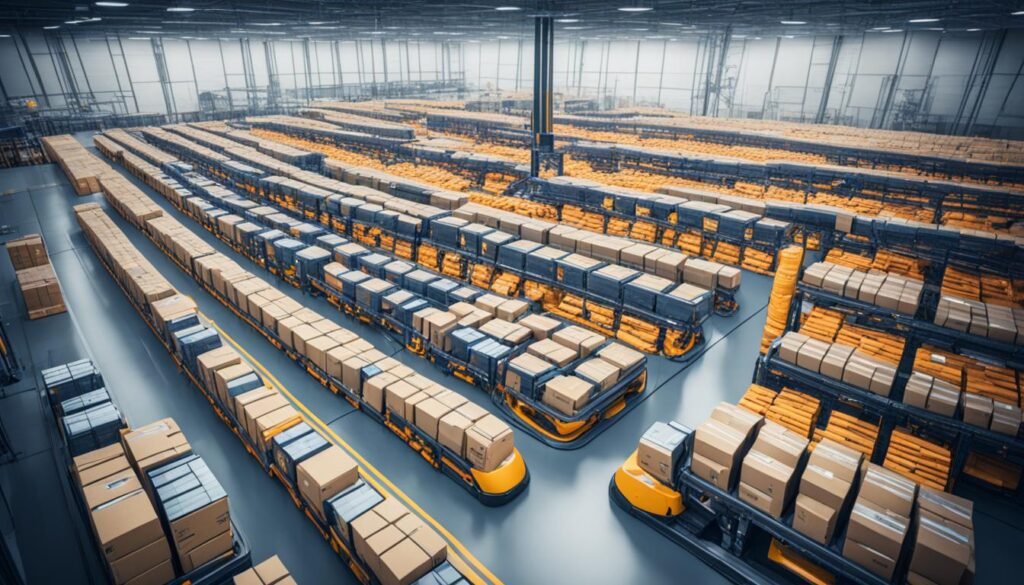
Educational Advancements Through AI and Machine Learning
Education has always been a cornerstone of society, and with the advent of artificial intelligence (AI) and machine learning (ML), it is undergoing a transformative revolution. AI and ML are empowering educators to provide personalized learning paths for students, enhancing the learning experience and improving student outcomes.
Personalized Learning Paths Enabled by AI
One of the key applications of AI in education is the creation of personalized learning paths for students. Machine learning algorithms analyze vast amounts of student data, including performance, strengths, weaknesses, and learning style, to tailor educational experiences specifically to each individual’s needs.
The ability to learn at one’s own pace and style is a game-changer. Personalized learning paths ensure that students receive the right content and support at the right time, allowing them to progress at their own speed. This approach helps students to better understand and retain information, promoting engagement and motivation.
Whether it’s through adaptive learning platforms or AI-powered educational software, personalized learning paths are revolutionizing traditional teaching methods and transforming the way students learn.
AI Tutoring Systems and Their Impact on Education

Another significant advancement in education through AI is the development of AI tutoring systems. These systems provide personalized feedback and support to students, acting as virtual tutors or mentors throughout their learning journey.
AI tutoring systems leverage machine learning algorithms to analyze student responses, identify areas of improvement, and provide targeted guidance. This individualized attention helps students overcome challenges and reinforces their understanding of concepts.
Moreover, AI tutoring systems can adapt their teaching style based on a student’s preferences and learning style. Whether a student excels with visual aids or prefers interactive exercises, AI tutoring systems can provide tailored materials and activities to optimize learning.
The impact of AI tutoring systems on education is immense. They enable educators to scale personalized instruction and bridge gaps in access to quality education. Students can receive support anytime, anywhere, leading to increased engagement, improved performance, and enhanced educational outcomes.
In conclusion, AI and ML are driving educational advancements by enabling personalized learning paths and AI tutoring systems. These innovations revolutionize traditional teaching methods, improve student engagement and performance, and provide equitable access to quality education. As technology continues to evolve, the future of education holds immense possibilities for transforming the way we teach and learn.
AI’s Role in the Transformation of Agriculture
Agriculture is undergoing a transformative shift with the integration of artificial intelligence (AI) technologies. The use of machine learning algorithms in precision farming and sustainable practices is revolutionizing the way crops are grown and managed. Through the analysis of data collected from various sources such as sensors, drones, and satellites, AI provides valuable insights into soil health, crop growth, and weather patterns.
AI in Precision Farming and Sustainable Practices
Precision farming practices aim to optimize the use of resources while minimizing environmental impact. With AI-powered analytics, farmers can make data-driven decisions regarding irrigation, fertilizer application, and pest control. By understanding the specific needs of each crop and field, AI enables farmers to implement precise interventions, reducing waste and improving overall sustainability.
AI technology also facilitates the integration of sustainable practices in agriculture. Farmers can leverage AI algorithms to develop crop rotation plans, optimize planting schedules, and implement biodiversity conservation strategies. These sustainable practices promote soil health, preserve natural resources, and contribute to the long-term resilience of agricultural systems.
Crop Monitoring and Management via Artificial Intelligence
Crop monitoring is a critical aspect of successful farming, and AI plays a vital role in this process. Through advanced image recognition and analysis, AI algorithms can identify and monitor crop health, detect diseases and pests, and assess nutrient deficiencies. The timely detection of issues allows farmers to take proactive measures, protecting their crops and minimizing yield losses.
AI-driven crop management systems provide real-time recommendations for optimal irrigation, fertilization, and harvesting. By continuously monitoring environmental conditions and crop performance, AI algorithms can adjust management practices to maximize yield and quality. This data-driven approach enhances productivity and efficiency in agriculture.
The integration of AI technologies in agriculture holds great potential for sustainable and efficient food production. With AI’s ability to analyze large amounts of data and provide valuable insights, farmers can make informed decisions that promote resource conservation, environmental stewardship, and increased crop yields. The transformation of agriculture through AI is poised to revolutionize the industry and address the challenges of feeding a growing global population.
The Emergence of AI in Cybersecurity Measures
AI is revolutionizing the field of cybersecurity, offering advanced tools and techniques to safeguard digital systems and protect sensitive information. With the increasing scale and complexity of cyber threats, AI has become an essential component in mitigating risks and enhancing the security of organizations.
One of the key capabilities of AI in cybersecurity is its ability to recognize patterns and anomalies in vast amounts of data. By analyzing this data, AI algorithms can identify potential cyberattacks and other security threats. This proactive approach allows organizations to detect and respond to threats in real-time, minimizing the potential damage and preventing future attacks.
The use of AI in cybersecurity measures also enables organizations to leverage machine learning algorithms for threat detection and prevention. These algorithms can continuously learn and adapt to evolving threats, improving their effectiveness over time. This dynamic nature of AI-powered cybersecurity measures ensures that organizations stay ahead of emerging threats and vulnerabilities.
Additionally, AI systems can automate routine security tasks, such as monitoring network activity, detecting and blocking suspicious traffic, and identifying vulnerabilities in systems and applications. This automation allows cybersecurity professionals to focus on more strategic and complex security challenges, improving operational efficiency and effectiveness.
In conclusion, AI is emerging as a crucial tool in cybersecurity measures, providing organizations with enhanced capabilities to protect against cyber threats. By leveraging AI technologies, organizations can strengthen their cybersecurity posture, detect and respond to threats in real-time, and stay ahead of evolving cyber threats. As the digital landscape continues to evolve, AI will continue to play a vital role in maintaining the integrity and security of digital systems.
Customer Experiences Enhanced by AI in E-Commerce
AI technology is transforming the e-commerce industry, revolutionizing customer experiences and driving business growth. Two key aspects that contribute significantly to enhancing customer interactions and insights in e-commerce are the use of chatbots and AI-driven analytics.
Using Chatbots for Improved Customer Interaction
Chatbots play a vital role in providing personalized customer support and interaction in the e-commerce landscape. These AI-powered virtual assistants can assist customers in finding products, answering queries, and providing a seamless shopping experience. By leveraging natural language processing and machine learning algorithms, chatbots can understand and respond to customer inquiries with speed and accuracy. This enables businesses to deliver exceptional customer service, improve engagement, and drive customer loyalty.
AI-Driven Analytics for Better Consumer Insights
AI-driven analytics is another essential component of enhancing customer experiences in e-commerce. By analyzing vast amounts of customer data, AI technologies can derive valuable insights into consumer preferences, behavior patterns, and purchasing habits. This data-driven approach enables businesses to gain a deeper understanding of their target audience, personalize marketing campaigns, and optimize product recommendations. With AI-driven analytics, e-commerce companies can improve consumer targeting, increase conversion rates, and drive business growth.
The applications of AI in e-commerce are transforming the industry, offering businesses the opportunity to create personalized customer experiences, improve customer satisfaction, and drive revenue. By leveraging chatbots for improved customer interaction and AI-driven analytics for better consumer insights, e-commerce companies can stay ahead of the competition and deliver exceptional value to their customers.
Artificial Intelligence in Business: Automating Routine Processes
AI’s Role in Streamlining Operations and Improving Efficiency
AI is revolutionizing the way businesses operate by automating routine processes and improving overall efficiency. With the power of AI, businesses can streamline their operations, optimize workflows, and minimize errors. By automating tasks such as data entry, document processing, and customer support, AI-powered systems reduce the need for human intervention, saving time and effort.
| Benefits of AI in Business | Examples of Routine Process Automation |
|---|---|
| 1. Improved productivity | 1. Data entry and data cleaning |
| 2. Cost savings | 2. Document processing and extraction |
| 3. Enhanced accuracy | 3. Customer support and chatbots |
| 4. Streamlined workflows | 4. Inventory management and order processing |
By leveraging AI technologies, businesses can focus on more strategic activities that require human expertise and creativity. The automated processes help free up valuable resources and enable employees to engage in higher-value tasks. This not only improves overall productivity but also enhances decision-making processes within the organization. AI’s ability to analyze vast amounts of data and provide real-time insights empowers businesses to make data-driven decisions and act proactively.
“AI-powered systems can handle routine tasks, allowing businesses to allocate their resources more efficiently.”
With AI streamlining operations, businesses can achieve greater efficiency and effectiveness in their daily processes. By optimizing workflows and minimizing errors, AI helps businesses achieve operational excellence and stay ahead of the competition.
Conclusion
Embracing the AI journey is crucial for businesses looking to thrive in today’s rapidly evolving world. The transformative power of AI is revolutionizing industries and unlocking new opportunities for growth and innovation. By harnessing the potential of AI, businesses can enhance decision-making, improve operational efficiency, and create exceptional customer experiences.
To fully embrace the AI journey, businesses must start by understanding the fundamentals of AI and machine learning. This includes grasping the concepts of neural networks, data science, and the differences between deep learning and traditional machine learning algorithms. With this foundational knowledge, businesses can explore the vast applications of AI in sectors such as healthcare, finance, manufacturing, retail, transportation, education, agriculture, cybersecurity, e-commerce, and business processes.
Key takeaways for businesses embarking on the AI journey include staying informed about the latest AI advancements and trends, as well as continuously exploring and evaluating AI opportunities in their respective industries. It is essential to keep pace with the evolving capabilities of AI and leverage its potential to stay competitive. By embracing AI as a strategic tool, businesses can unlock new levels of efficiency, innovation, and success in the future.
The future of AI is promising. As AI continues to advance, businesses should adopt a proactive mindset, actively seeking ways to integrate AI technologies into their operations and strategies. Businesses that embrace the AI journey today will be well-positioned for future success as AI continues to reshape industries and drive new levels of productivity and innovation.
FAQ
What is artificial intelligence (AI) and machine learning (ML)?
How do neural networks and data science contribute to AI and ML?
How do machine learning algorithms power AI progress?
What is the difference between deep learning and traditional machine learning?
How is AI transforming the healthcare industry?
What are the applications of AI and ML in the finance industry?
How does AI play a role in manufacturing and Industry 4.0?
How is AI transforming the retail industry?
How is AI reshaping the transportation and logistics industry?
How does AI contribute to the transformation of education?
How is AI revolutionizing the agricultural industry?
What is the role of AI in cybersecurity measures?
How does AI enhance customer experiences in e-commerce?
How does AI automate routine processes and improve business efficiency?
What are the key takeaways for businesses in embracing the AI and ML journey?
How can businesses keep pace with AI advancements?
Source Links
- https://www.linkedin.com/pulse/how-ai-machine-learning-revolutionizing-industries
- https://www.supplychainconnect.com/supply-chain-technology/article/21266348/how-artificial-intelligence-is-transforming-every-industry
- https://www.businessnewsdaily.com/9402-artificial-intelligence-business-trends.html

